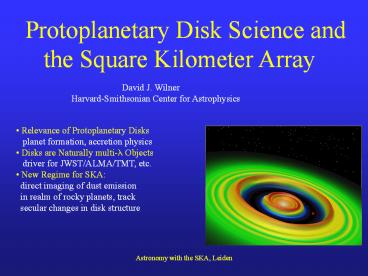Protoplanetary Disk Science and - PowerPoint PPT Presentation
1 / 13
Title:
Protoplanetary Disk Science and
Description:
configuration, 7 mm. eVLA could easily. image 4 AU radius. hole (if it exists) ... radio/mm data provide. direct measure of b, diagnostic of grain size, shape, ... – PowerPoint PPT presentation
Number of Views:69
Avg rating:3.0/5.0
Title: Protoplanetary Disk Science and
1
Protoplanetary Disk Science and the Square
Kilometer Array
David J. Wilner Harvard-Smit
hsonian Center for Astrophysics
- Relevance of Protoplanetary Disks
- planet formation, accretion physics
- Disks are Naturally multi-l Objects
- driver for JWST/ALMA/TMT, etc.
- New Regime for SKA
- direct imaging of dust emission
- in realm of rocky planets, track
- secular changes in disk structure
2
Stages of Planetary System Formation
3
Planet Building
- How do planets form? What accounts for the
diversity of planetary - systems? How common are Solar Systems like our
own? - Observe young stellar systems to identify
- 1. physical processes (e.g. grain growth,
orbital migration) - 2. signatures of planets in formation (gaps in
disks) - There are large numbers (100s) of
protoplanetary disks at 140 pc size scale of
regions relevant for planets is lt 10 AU, i.e. 70
mas - (protoplanetary means enough gas to form giant
planets)
4
Next Generation High Resolution Imaging
ALMA dust emission q 13 mas x (345 GHz/18
km) (and molecular line emission at much lower
resolution) TMT scattered light q 13 mas x
(1.6 mm/30 m) (and infrared spectroscopy that
probes inner disks indirectly) SKA (low t) dust
emission q 1 mas x (24 GHz/2000 km) long ls
have advantage of low opacity to penetrate inner
disks for rms 10 K at q 1 mas, need rms 10
nJy
TW Hya
5
State-of-the-Art Disk Images
TW Hya _at_56 pc
Hubble Space Telescope optical scattered light
(Schneider et al. 2001)
Very Large Array 7mm dust emission (Wilner et
al. 2000) SKA resolution will be better by 100x
6
Physical Models of Disk Structure
- physical models now
- taking place of power law parameterizations
- self-consistent treatment
- of radiative and hydro-
- static equilibrium using
- 11D radiative transfer
S(r)
T(r)
h(r)
e.g. Chiang Goldreich 1997, 99 DAlessio et
al. 1997, 98 , 99... Dullemond et al. 2000, 01,
02...
for steady a accretionS m/3pn (r3/2Tm) -1
r -p , p 1 (except inner disk)
SED
DAlessio et al. 2001
7
Testing Disk Structure Models
- comparison of models with sparse array
- data is often best done in visibility domain
TW Hya SMA 0.87 mm Qi et al., in prep
- Calvet et al. (2002)
- irradiated accretion disk
- model matches SED and
- 7 mm, 0.87 mm images
8
TW Hya an eVLA Simulation
- physical model of
- irradiated accretion
- disk adapted from
- Calvet et al. (2002)
- ApJ, 568, 1008
- VLA Pie Town
- configuration, 7 mm
- eVLA could easily
- image 4 AU radius
- hole (if it exists)
9
Are Protoplanetary Gaps Detectable?
ALMA
VLTI
Wolf et al. 2002
Brightness distributions from hydrodynamical
simulations of a disk with an embedded Jupiter
mass planet for the VLTI at 10 mm, and for ALMA
at 700 mm. The gap lies 37 mas (5.2 AU) from the
star.
10
Evidence for Grain Growth in Disks
- at long ls where tlt1,
- F kdust l-2 l-(b2) , so
- radio/mm data provide
- direct measure of b,
- diagnostic of grain size,
- shape, composition
- compact, spherical particles
- with a ltlt l, b2
- pebbles, rocks, asteroids
- with a gtgt l, b0
Beckwith and Sargent 1991
If F l-2 , then large grains? or compact
structure with tgt1?
resolve ambiguity...
11
Example Large Grains in CQ Tau
- CQ Tau
- M 1.5 Mo,
- age 10 Myr
- spectral index
- 1 mm to 7 mm 2.4
- 7 mm emission
- resolved by VLA,
- models indicate
- t lt 1 for r gt 8 AU,
- R 200 AU (p1),
- kdust l-0.6
- most of dust mass
- in cm-size grains
Testi et al. 2003
12
Example the DG TAU Protostellar System
- well-studied, very
- active, T Tauri star
- optical jet P.A. 226
- VLAPT at 7 mm
- sees inner dust disk,
- q 35 mas, DK 20
- where is the star? at
- the peak? in the hole?what produces the
- asymmetry? are any
- blobs jet plasma?how does the structure
- change with time?
13
SKA could play Unique Role in Disk Studies
- If capable at gt 20 GHz, SKA will have best
resolution - for imaging thermal emission.
- For direct detection of structure
- in disks induced by planets,
- sub-AU resolution is key.
- (synergy with other facilities)
- High angular resolution probes
- terrestrial planet region and
- enables following evolution
- over orbital timescales.
- Short centimeter wavelengths
- are critical for tracking grain growth from
sub-micron - interstellar size particles to pebbles.
Bate et al. 2003































